Report on Team Building in Business: Positive Youth Foundation
VerifiedAdded on 2021/02/20
|9
|2807
|31
Report
AI Summary
This report provides a comprehensive analysis of team building in a business context, specifically focusing on the Positive Youth Foundation. It begins with an introduction to team building, defining its importance and purpose in achieving organizational objectives. The report then delves into different types of teams, including functional, cross-functional, virtual, and self-directed teams, highlighting their characteristics and applications. The benefits of effective team building, such as improved communication, equal contribution, and a focus on goals, are also discussed. Task 2 focuses on Tuckman's model of team stages (forming, storming, norming, and performing) and its relevance to team development within the organization, including the role of coordinators, team workers, specialists, and resource investigators. The report also addresses conflict resolution strategies and methods to enhance team cohesiveness, emphasizing the importance of communication, feedback, and social opportunities. Overall, the report offers practical insights into building and managing effective teams to enhance organizational performance and achieve goals, with a focus on the Positive Youth Foundation's context.
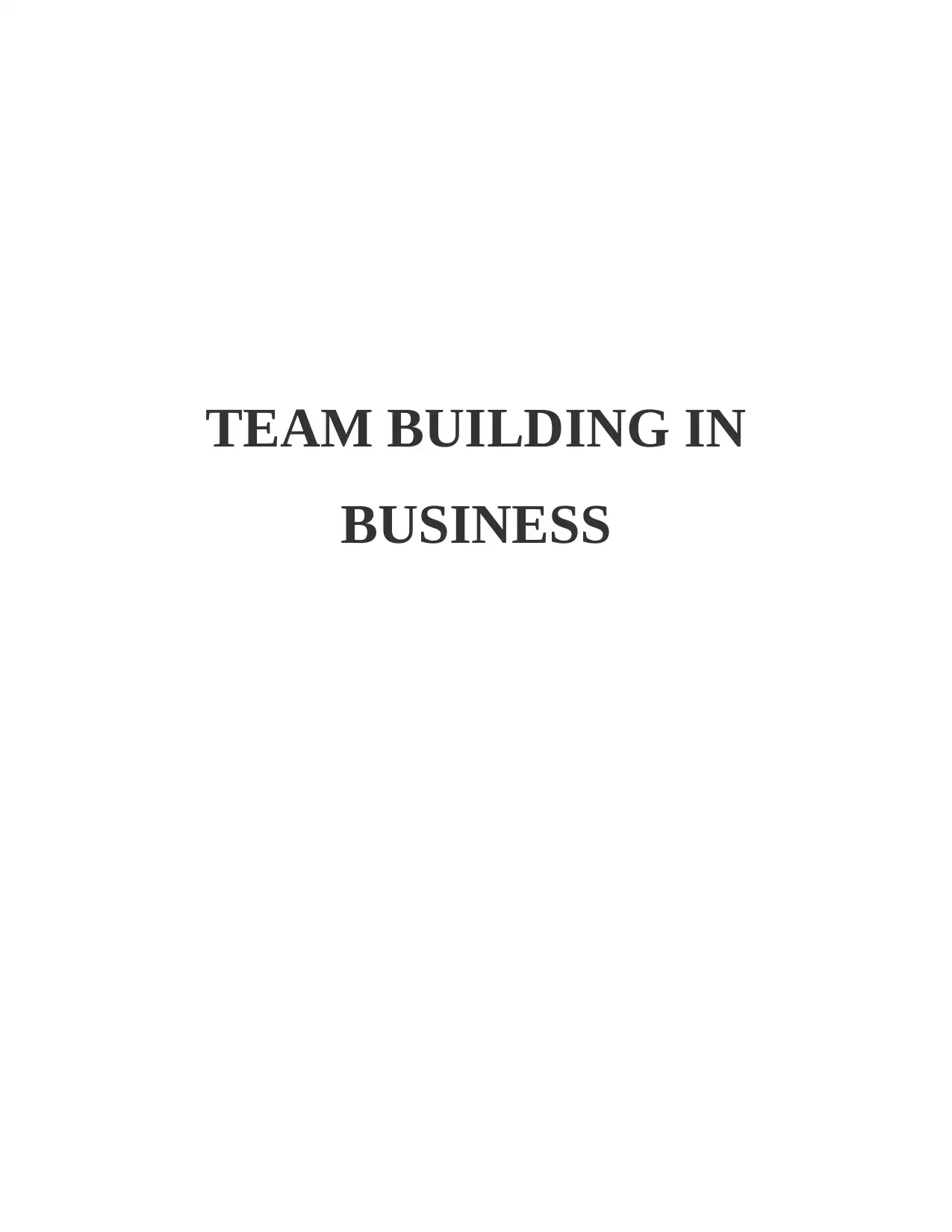
TEAM BUILDING IN
BUSINESS
BUSINESS
Paraphrase This Document
Need a fresh take? Get an instant paraphrase of this document with our AI Paraphraser
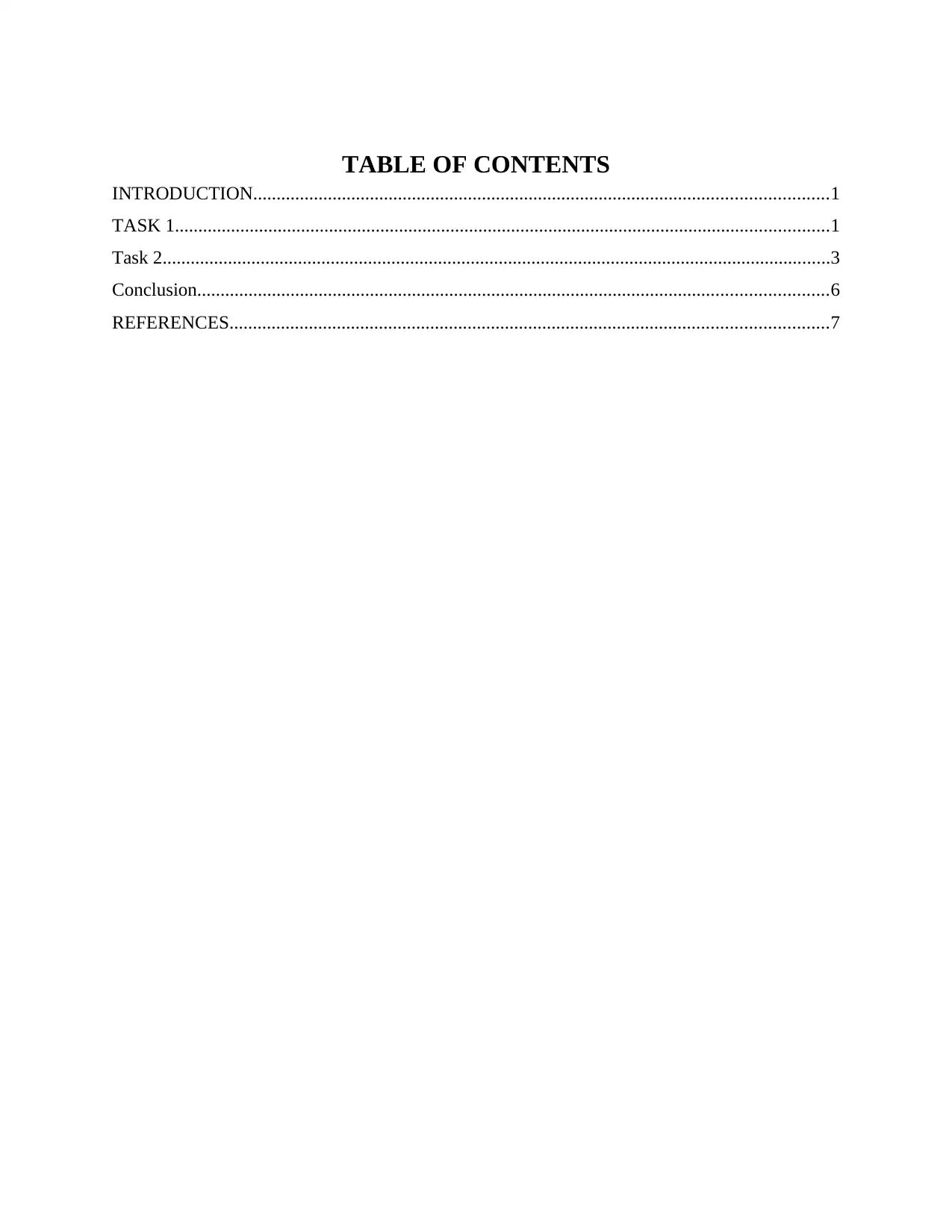
TABLE OF CONTENTS
INTRODUCTION...........................................................................................................................1
TASK 1............................................................................................................................................1
Task 2...............................................................................................................................................3
Conclusion.......................................................................................................................................6
REFERENCES................................................................................................................................7
INTRODUCTION...........................................................................................................................1
TASK 1............................................................................................................................................1
Task 2...............................................................................................................................................3
Conclusion.......................................................................................................................................6
REFERENCES................................................................................................................................7
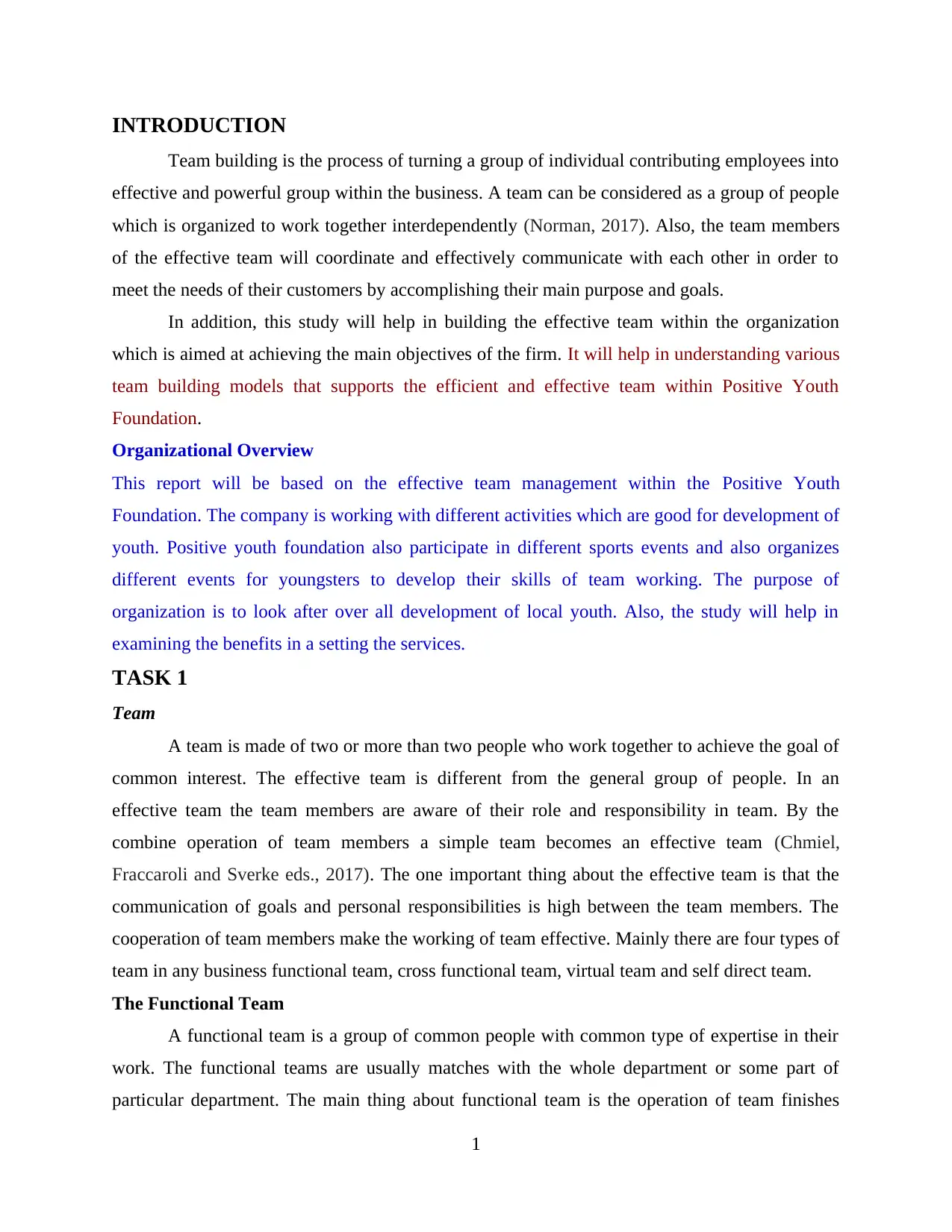
INTRODUCTION
Team building is the process of turning a group of individual contributing employees into
effective and powerful group within the business. A team can be considered as a group of people
which is organized to work together interdependently (Norman, 2017). Also, the team members
of the effective team will coordinate and effectively communicate with each other in order to
meet the needs of their customers by accomplishing their main purpose and goals.
In addition, this study will help in building the effective team within the organization
which is aimed at achieving the main objectives of the firm. It will help in understanding various
team building models that supports the efficient and effective team within Positive Youth
Foundation.
Organizational Overview
This report will be based on the effective team management within the Positive Youth
Foundation. The company is working with different activities which are good for development of
youth. Positive youth foundation also participate in different sports events and also organizes
different events for youngsters to develop their skills of team working. The purpose of
organization is to look after over all development of local youth. Also, the study will help in
examining the benefits in a setting the services.
TASK 1
Team
A team is made of two or more than two people who work together to achieve the goal of
common interest. The effective team is different from the general group of people. In an
effective team the team members are aware of their role and responsibility in team. By the
combine operation of team members a simple team becomes an effective team (Chmiel,
Fraccaroli and Sverke eds., 2017). The one important thing about the effective team is that the
communication of goals and personal responsibilities is high between the team members. The
cooperation of team members make the working of team effective. Mainly there are four types of
team in any business functional team, cross functional team, virtual team and self direct team.
The Functional Team
A functional team is a group of common people with common type of expertise in their
work. The functional teams are usually matches with the whole department or some part of
particular department. The main thing about functional team is the operation of team finishes
1
Team building is the process of turning a group of individual contributing employees into
effective and powerful group within the business. A team can be considered as a group of people
which is organized to work together interdependently (Norman, 2017). Also, the team members
of the effective team will coordinate and effectively communicate with each other in order to
meet the needs of their customers by accomplishing their main purpose and goals.
In addition, this study will help in building the effective team within the organization
which is aimed at achieving the main objectives of the firm. It will help in understanding various
team building models that supports the efficient and effective team within Positive Youth
Foundation.
Organizational Overview
This report will be based on the effective team management within the Positive Youth
Foundation. The company is working with different activities which are good for development of
youth. Positive youth foundation also participate in different sports events and also organizes
different events for youngsters to develop their skills of team working. The purpose of
organization is to look after over all development of local youth. Also, the study will help in
examining the benefits in a setting the services.
TASK 1
Team
A team is made of two or more than two people who work together to achieve the goal of
common interest. The effective team is different from the general group of people. In an
effective team the team members are aware of their role and responsibility in team. By the
combine operation of team members a simple team becomes an effective team (Chmiel,
Fraccaroli and Sverke eds., 2017). The one important thing about the effective team is that the
communication of goals and personal responsibilities is high between the team members. The
cooperation of team members make the working of team effective. Mainly there are four types of
team in any business functional team, cross functional team, virtual team and self direct team.
The Functional Team
A functional team is a group of common people with common type of expertise in their
work. The functional teams are usually matches with the whole department or some part of
particular department. The main thing about functional team is the operation of team finishes
1
⊘ This is a preview!⊘
Do you want full access?
Subscribe today to unlock all pages.

Trusted by 1+ million students worldwide
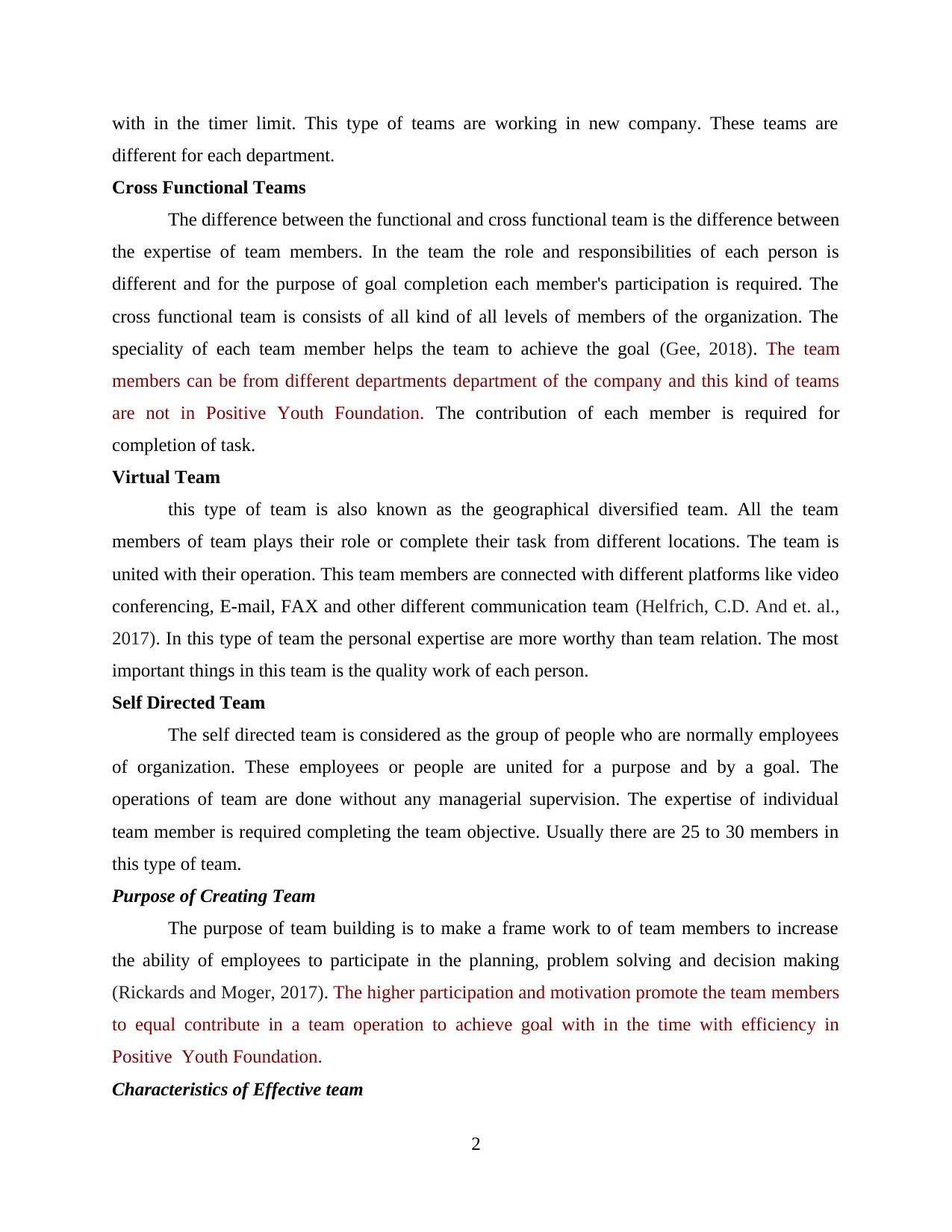
with in the timer limit. This type of teams are working in new company. These teams are
different for each department.
Cross Functional Teams
The difference between the functional and cross functional team is the difference between
the expertise of team members. In the team the role and responsibilities of each person is
different and for the purpose of goal completion each member's participation is required. The
cross functional team is consists of all kind of all levels of members of the organization. The
speciality of each team member helps the team to achieve the goal (Gee, 2018). The team
members can be from different departments department of the company and this kind of teams
are not in Positive Youth Foundation. The contribution of each member is required for
completion of task.
Virtual Team
this type of team is also known as the geographical diversified team. All the team
members of team plays their role or complete their task from different locations. The team is
united with their operation. This team members are connected with different platforms like video
conferencing, E-mail, FAX and other different communication team (Helfrich, C.D. And et. al.,
2017). In this type of team the personal expertise are more worthy than team relation. The most
important things in this team is the quality work of each person.
Self Directed Team
The self directed team is considered as the group of people who are normally employees
of organization. These employees or people are united for a purpose and by a goal. The
operations of team are done without any managerial supervision. The expertise of individual
team member is required completing the team objective. Usually there are 25 to 30 members in
this type of team.
Purpose of Creating Team
The purpose of team building is to make a frame work to of team members to increase
the ability of employees to participate in the planning, problem solving and decision making
(Rickards and Moger, 2017). The higher participation and motivation promote the team members
to equal contribute in a team operation to achieve goal with in the time with efficiency in
Positive Youth Foundation.
Characteristics of Effective team
2
different for each department.
Cross Functional Teams
The difference between the functional and cross functional team is the difference between
the expertise of team members. In the team the role and responsibilities of each person is
different and for the purpose of goal completion each member's participation is required. The
cross functional team is consists of all kind of all levels of members of the organization. The
speciality of each team member helps the team to achieve the goal (Gee, 2018). The team
members can be from different departments department of the company and this kind of teams
are not in Positive Youth Foundation. The contribution of each member is required for
completion of task.
Virtual Team
this type of team is also known as the geographical diversified team. All the team
members of team plays their role or complete their task from different locations. The team is
united with their operation. This team members are connected with different platforms like video
conferencing, E-mail, FAX and other different communication team (Helfrich, C.D. And et. al.,
2017). In this type of team the personal expertise are more worthy than team relation. The most
important things in this team is the quality work of each person.
Self Directed Team
The self directed team is considered as the group of people who are normally employees
of organization. These employees or people are united for a purpose and by a goal. The
operations of team are done without any managerial supervision. The expertise of individual
team member is required completing the team objective. Usually there are 25 to 30 members in
this type of team.
Purpose of Creating Team
The purpose of team building is to make a frame work to of team members to increase
the ability of employees to participate in the planning, problem solving and decision making
(Rickards and Moger, 2017). The higher participation and motivation promote the team members
to equal contribute in a team operation to achieve goal with in the time with efficiency in
Positive Youth Foundation.
Characteristics of Effective team
2
Paraphrase This Document
Need a fresh take? Get an instant paraphrase of this document with our AI Paraphraser
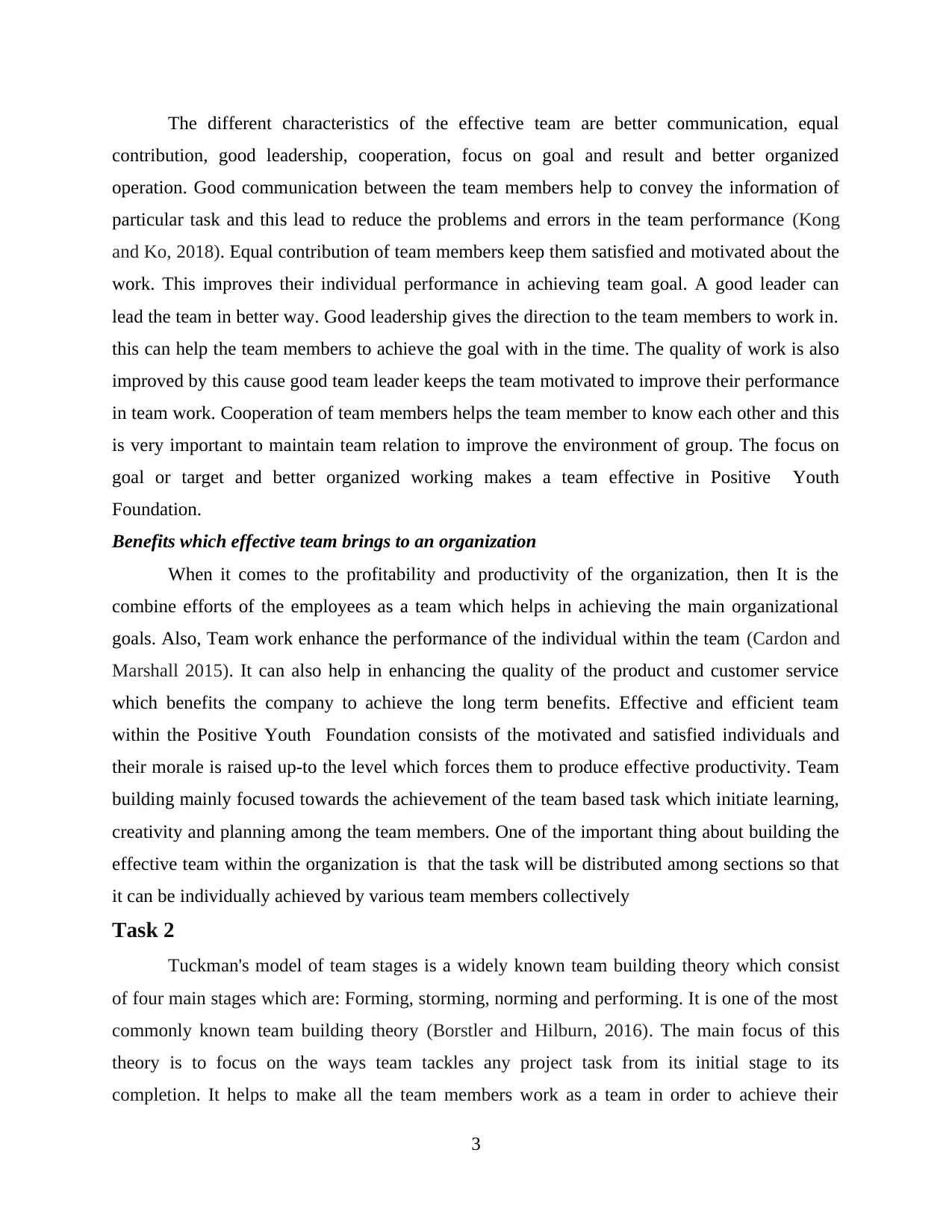
The different characteristics of the effective team are better communication, equal
contribution, good leadership, cooperation, focus on goal and result and better organized
operation. Good communication between the team members help to convey the information of
particular task and this lead to reduce the problems and errors in the team performance (Kong
and Ko, 2018). Equal contribution of team members keep them satisfied and motivated about the
work. This improves their individual performance in achieving team goal. A good leader can
lead the team in better way. Good leadership gives the direction to the team members to work in.
this can help the team members to achieve the goal with in the time. The quality of work is also
improved by this cause good team leader keeps the team motivated to improve their performance
in team work. Cooperation of team members helps the team member to know each other and this
is very important to maintain team relation to improve the environment of group. The focus on
goal or target and better organized working makes a team effective in Positive Youth
Foundation.
Benefits which effective team brings to an organization
When it comes to the profitability and productivity of the organization, then It is the
combine efforts of the employees as a team which helps in achieving the main organizational
goals. Also, Team work enhance the performance of the individual within the team (Cardon and
Marshall 2015). It can also help in enhancing the quality of the product and customer service
which benefits the company to achieve the long term benefits. Effective and efficient team
within the Positive Youth Foundation consists of the motivated and satisfied individuals and
their morale is raised up-to the level which forces them to produce effective productivity. Team
building mainly focused towards the achievement of the team based task which initiate learning,
creativity and planning among the team members. One of the important thing about building the
effective team within the organization is that the task will be distributed among sections so that
it can be individually achieved by various team members collectively
Task 2
Tuckman's model of team stages is a widely known team building theory which consist
of four main stages which are: Forming, storming, norming and performing. It is one of the most
commonly known team building theory (Borstler and Hilburn, 2016). The main focus of this
theory is to focus on the ways team tackles any project task from its initial stage to its
completion. It helps to make all the team members work as a team in order to achieve their
3
contribution, good leadership, cooperation, focus on goal and result and better organized
operation. Good communication between the team members help to convey the information of
particular task and this lead to reduce the problems and errors in the team performance (Kong
and Ko, 2018). Equal contribution of team members keep them satisfied and motivated about the
work. This improves their individual performance in achieving team goal. A good leader can
lead the team in better way. Good leadership gives the direction to the team members to work in.
this can help the team members to achieve the goal with in the time. The quality of work is also
improved by this cause good team leader keeps the team motivated to improve their performance
in team work. Cooperation of team members helps the team member to know each other and this
is very important to maintain team relation to improve the environment of group. The focus on
goal or target and better organized working makes a team effective in Positive Youth
Foundation.
Benefits which effective team brings to an organization
When it comes to the profitability and productivity of the organization, then It is the
combine efforts of the employees as a team which helps in achieving the main organizational
goals. Also, Team work enhance the performance of the individual within the team (Cardon and
Marshall 2015). It can also help in enhancing the quality of the product and customer service
which benefits the company to achieve the long term benefits. Effective and efficient team
within the Positive Youth Foundation consists of the motivated and satisfied individuals and
their morale is raised up-to the level which forces them to produce effective productivity. Team
building mainly focused towards the achievement of the team based task which initiate learning,
creativity and planning among the team members. One of the important thing about building the
effective team within the organization is that the task will be distributed among sections so that
it can be individually achieved by various team members collectively
Task 2
Tuckman's model of team stages is a widely known team building theory which consist
of four main stages which are: Forming, storming, norming and performing. It is one of the most
commonly known team building theory (Borstler and Hilburn, 2016). The main focus of this
theory is to focus on the ways team tackles any project task from its initial stage to its
completion. It helps to make all the team members work as a team in order to achieve their
3
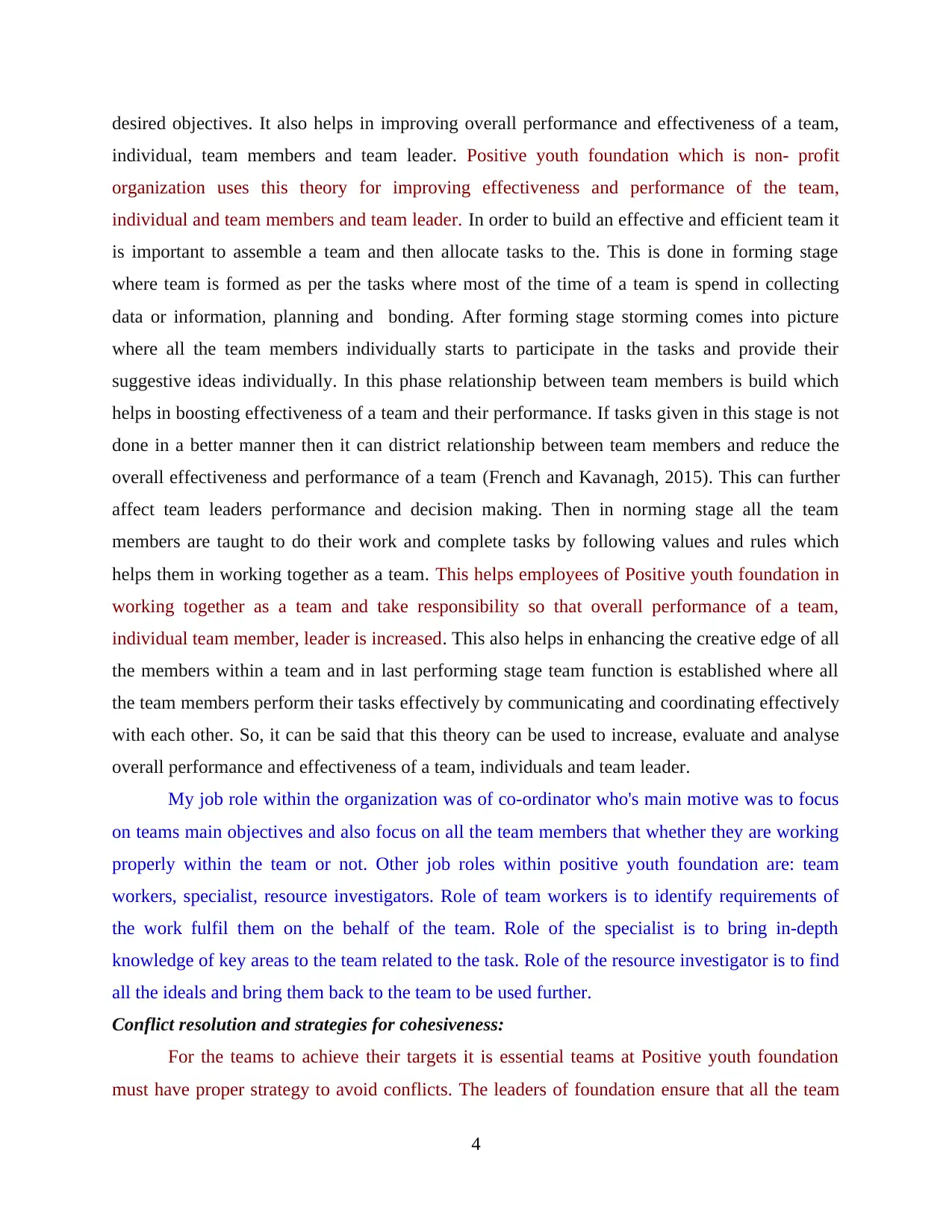
desired objectives. It also helps in improving overall performance and effectiveness of a team,
individual, team members and team leader. Positive youth foundation which is non- profit
organization uses this theory for improving effectiveness and performance of the team,
individual and team members and team leader. In order to build an effective and efficient team it
is important to assemble a team and then allocate tasks to the. This is done in forming stage
where team is formed as per the tasks where most of the time of a team is spend in collecting
data or information, planning and bonding. After forming stage storming comes into picture
where all the team members individually starts to participate in the tasks and provide their
suggestive ideas individually. In this phase relationship between team members is build which
helps in boosting effectiveness of a team and their performance. If tasks given in this stage is not
done in a better manner then it can district relationship between team members and reduce the
overall effectiveness and performance of a team (French and Kavanagh, 2015). This can further
affect team leaders performance and decision making. Then in norming stage all the team
members are taught to do their work and complete tasks by following values and rules which
helps them in working together as a team. This helps employees of Positive youth foundation in
working together as a team and take responsibility so that overall performance of a team,
individual team member, leader is increased. This also helps in enhancing the creative edge of all
the members within a team and in last performing stage team function is established where all
the team members perform their tasks effectively by communicating and coordinating effectively
with each other. So, it can be said that this theory can be used to increase, evaluate and analyse
overall performance and effectiveness of a team, individuals and team leader.
My job role within the organization was of co-ordinator who's main motive was to focus
on teams main objectives and also focus on all the team members that whether they are working
properly within the team or not. Other job roles within positive youth foundation are: team
workers, specialist, resource investigators. Role of team workers is to identify requirements of
the work fulfil them on the behalf of the team. Role of the specialist is to bring in-depth
knowledge of key areas to the team related to the task. Role of the resource investigator is to find
all the ideals and bring them back to the team to be used further.
Conflict resolution and strategies for cohesiveness:
For the teams to achieve their targets it is essential teams at Positive youth foundation
must have proper strategy to avoid conflicts. The leaders of foundation ensure that all the team
4
individual, team members and team leader. Positive youth foundation which is non- profit
organization uses this theory for improving effectiveness and performance of the team,
individual and team members and team leader. In order to build an effective and efficient team it
is important to assemble a team and then allocate tasks to the. This is done in forming stage
where team is formed as per the tasks where most of the time of a team is spend in collecting
data or information, planning and bonding. After forming stage storming comes into picture
where all the team members individually starts to participate in the tasks and provide their
suggestive ideas individually. In this phase relationship between team members is build which
helps in boosting effectiveness of a team and their performance. If tasks given in this stage is not
done in a better manner then it can district relationship between team members and reduce the
overall effectiveness and performance of a team (French and Kavanagh, 2015). This can further
affect team leaders performance and decision making. Then in norming stage all the team
members are taught to do their work and complete tasks by following values and rules which
helps them in working together as a team. This helps employees of Positive youth foundation in
working together as a team and take responsibility so that overall performance of a team,
individual team member, leader is increased. This also helps in enhancing the creative edge of all
the members within a team and in last performing stage team function is established where all
the team members perform their tasks effectively by communicating and coordinating effectively
with each other. So, it can be said that this theory can be used to increase, evaluate and analyse
overall performance and effectiveness of a team, individuals and team leader.
My job role within the organization was of co-ordinator who's main motive was to focus
on teams main objectives and also focus on all the team members that whether they are working
properly within the team or not. Other job roles within positive youth foundation are: team
workers, specialist, resource investigators. Role of team workers is to identify requirements of
the work fulfil them on the behalf of the team. Role of the specialist is to bring in-depth
knowledge of key areas to the team related to the task. Role of the resource investigator is to find
all the ideals and bring them back to the team to be used further.
Conflict resolution and strategies for cohesiveness:
For the teams to achieve their targets it is essential teams at Positive youth foundation
must have proper strategy to avoid conflicts. The leaders of foundation ensure that all the team
4
⊘ This is a preview!⊘
Do you want full access?
Subscribe today to unlock all pages.

Trusted by 1+ million students worldwide
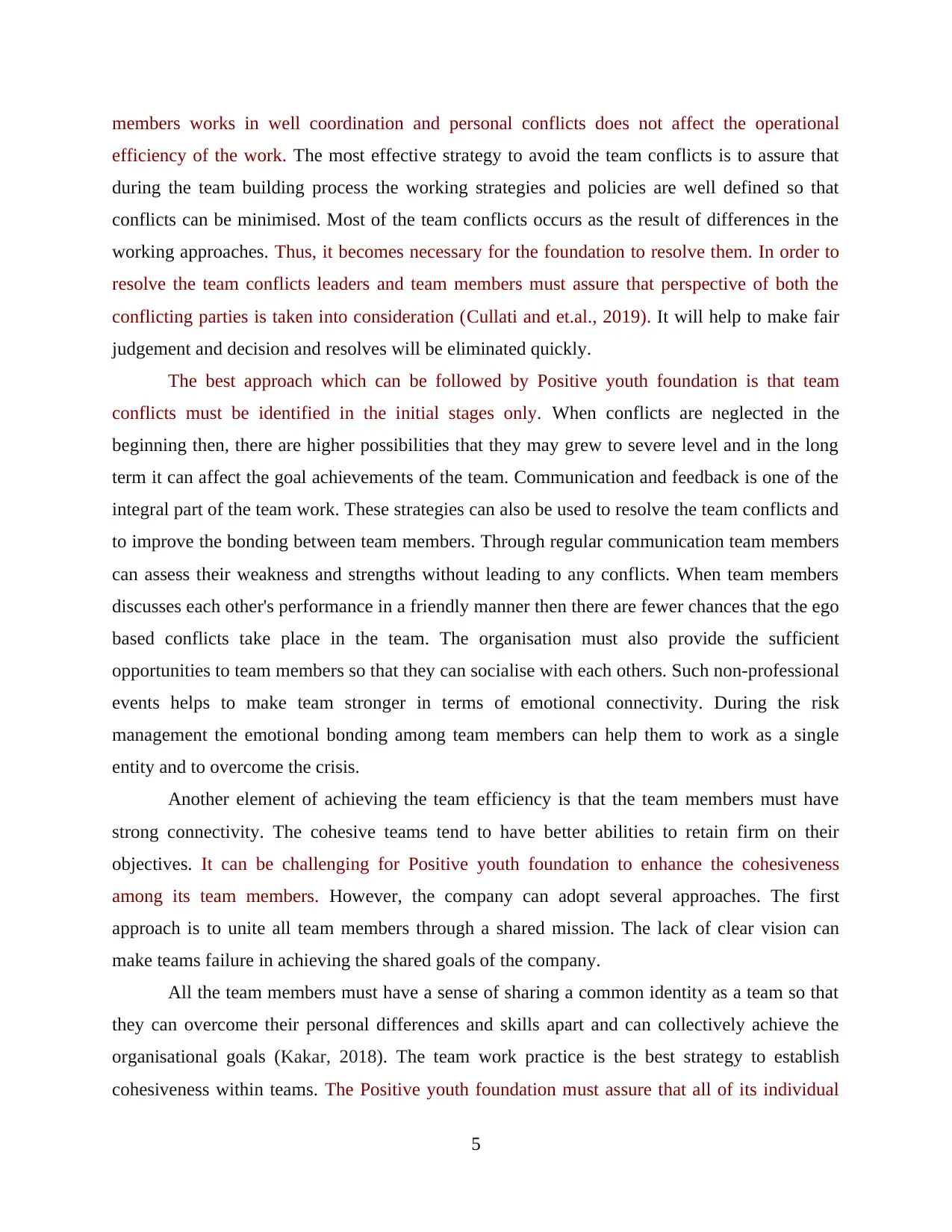
members works in well coordination and personal conflicts does not affect the operational
efficiency of the work. The most effective strategy to avoid the team conflicts is to assure that
during the team building process the working strategies and policies are well defined so that
conflicts can be minimised. Most of the team conflicts occurs as the result of differences in the
working approaches. Thus, it becomes necessary for the foundation to resolve them. In order to
resolve the team conflicts leaders and team members must assure that perspective of both the
conflicting parties is taken into consideration (Cullati and et.al., 2019). It will help to make fair
judgement and decision and resolves will be eliminated quickly.
The best approach which can be followed by Positive youth foundation is that team
conflicts must be identified in the initial stages only. When conflicts are neglected in the
beginning then, there are higher possibilities that they may grew to severe level and in the long
term it can affect the goal achievements of the team. Communication and feedback is one of the
integral part of the team work. These strategies can also be used to resolve the team conflicts and
to improve the bonding between team members. Through regular communication team members
can assess their weakness and strengths without leading to any conflicts. When team members
discusses each other's performance in a friendly manner then there are fewer chances that the ego
based conflicts take place in the team. The organisation must also provide the sufficient
opportunities to team members so that they can socialise with each others. Such non-professional
events helps to make team stronger in terms of emotional connectivity. During the risk
management the emotional bonding among team members can help them to work as a single
entity and to overcome the crisis.
Another element of achieving the team efficiency is that the team members must have
strong connectivity. The cohesive teams tend to have better abilities to retain firm on their
objectives. It can be challenging for Positive youth foundation to enhance the cohesiveness
among its team members. However, the company can adopt several approaches. The first
approach is to unite all team members through a shared mission. The lack of clear vision can
make teams failure in achieving the shared goals of the company.
All the team members must have a sense of sharing a common identity as a team so that
they can overcome their personal differences and skills apart and can collectively achieve the
organisational goals (Kakar, 2018). The team work practice is the best strategy to establish
cohesiveness within teams. The Positive youth foundation must assure that all of its individual
5
efficiency of the work. The most effective strategy to avoid the team conflicts is to assure that
during the team building process the working strategies and policies are well defined so that
conflicts can be minimised. Most of the team conflicts occurs as the result of differences in the
working approaches. Thus, it becomes necessary for the foundation to resolve them. In order to
resolve the team conflicts leaders and team members must assure that perspective of both the
conflicting parties is taken into consideration (Cullati and et.al., 2019). It will help to make fair
judgement and decision and resolves will be eliminated quickly.
The best approach which can be followed by Positive youth foundation is that team
conflicts must be identified in the initial stages only. When conflicts are neglected in the
beginning then, there are higher possibilities that they may grew to severe level and in the long
term it can affect the goal achievements of the team. Communication and feedback is one of the
integral part of the team work. These strategies can also be used to resolve the team conflicts and
to improve the bonding between team members. Through regular communication team members
can assess their weakness and strengths without leading to any conflicts. When team members
discusses each other's performance in a friendly manner then there are fewer chances that the ego
based conflicts take place in the team. The organisation must also provide the sufficient
opportunities to team members so that they can socialise with each others. Such non-professional
events helps to make team stronger in terms of emotional connectivity. During the risk
management the emotional bonding among team members can help them to work as a single
entity and to overcome the crisis.
Another element of achieving the team efficiency is that the team members must have
strong connectivity. The cohesive teams tend to have better abilities to retain firm on their
objectives. It can be challenging for Positive youth foundation to enhance the cohesiveness
among its team members. However, the company can adopt several approaches. The first
approach is to unite all team members through a shared mission. The lack of clear vision can
make teams failure in achieving the shared goals of the company.
All the team members must have a sense of sharing a common identity as a team so that
they can overcome their personal differences and skills apart and can collectively achieve the
organisational goals (Kakar, 2018). The team work practice is the best strategy to establish
cohesiveness within teams. The Positive youth foundation must assure that all of its individual
5
Paraphrase This Document
Need a fresh take? Get an instant paraphrase of this document with our AI Paraphraser
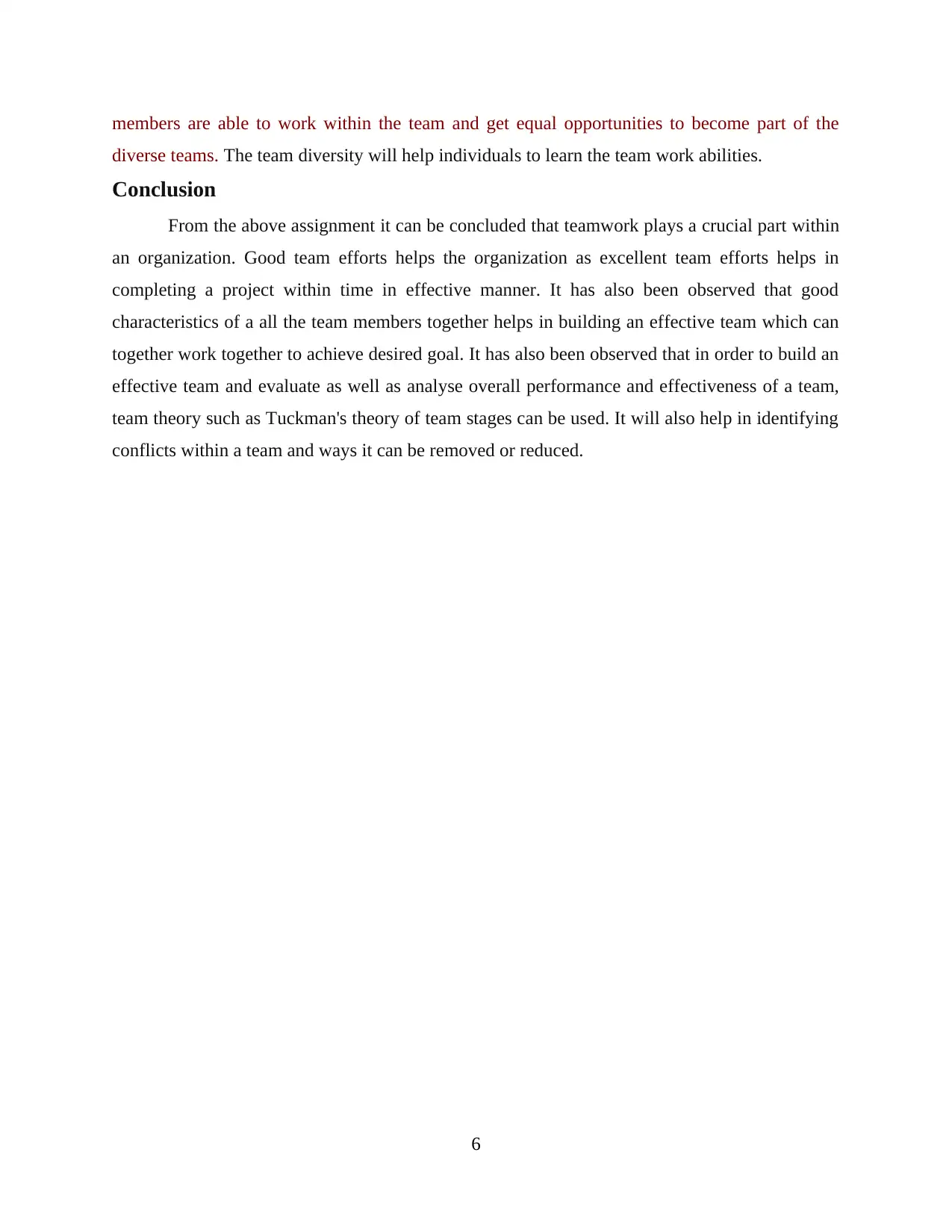
members are able to work within the team and get equal opportunities to become part of the
diverse teams. The team diversity will help individuals to learn the team work abilities.
Conclusion
From the above assignment it can be concluded that teamwork plays a crucial part within
an organization. Good team efforts helps the organization as excellent team efforts helps in
completing a project within time in effective manner. It has also been observed that good
characteristics of a all the team members together helps in building an effective team which can
together work together to achieve desired goal. It has also been observed that in order to build an
effective team and evaluate as well as analyse overall performance and effectiveness of a team,
team theory such as Tuckman's theory of team stages can be used. It will also help in identifying
conflicts within a team and ways it can be removed or reduced.
6
diverse teams. The team diversity will help individuals to learn the team work abilities.
Conclusion
From the above assignment it can be concluded that teamwork plays a crucial part within
an organization. Good team efforts helps the organization as excellent team efforts helps in
completing a project within time in effective manner. It has also been observed that good
characteristics of a all the team members together helps in building an effective team which can
together work together to achieve desired goal. It has also been observed that in order to build an
effective team and evaluate as well as analyse overall performance and effectiveness of a team,
team theory such as Tuckman's theory of team stages can be used. It will also help in identifying
conflicts within a team and ways it can be removed or reduced.
6
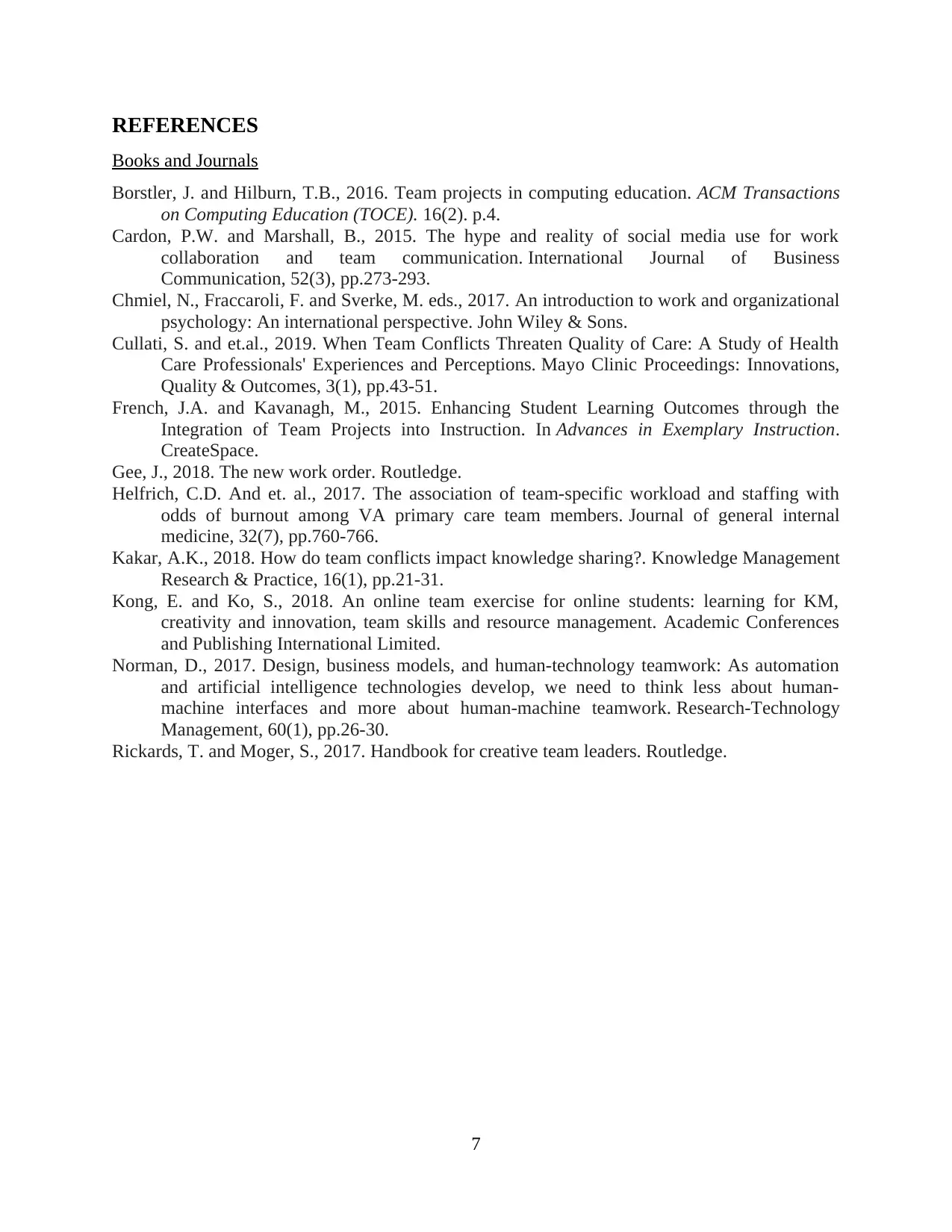
REFERENCES
Books and Journals
Borstler, J. and Hilburn, T.B., 2016. Team projects in computing education. ACM Transactions
on Computing Education (TOCE). 16(2). p.4.
Cardon, P.W. and Marshall, B., 2015. The hype and reality of social media use for work
collaboration and team communication. International Journal of Business
Communication, 52(3), pp.273-293.
Chmiel, N., Fraccaroli, F. and Sverke, M. eds., 2017. An introduction to work and organizational
psychology: An international perspective. John Wiley & Sons.
Cullati, S. and et.al., 2019. When Team Conflicts Threaten Quality of Care: A Study of Health
Care Professionals' Experiences and Perceptions. Mayo Clinic Proceedings: Innovations,
Quality & Outcomes, 3(1), pp.43-51.
French, J.A. and Kavanagh, M., 2015. Enhancing Student Learning Outcomes through the
Integration of Team Projects into Instruction. In Advances in Exemplary Instruction.
CreateSpace.
Gee, J., 2018. The new work order. Routledge.
Helfrich, C.D. And et. al., 2017. The association of team-specific workload and staffing with
odds of burnout among VA primary care team members. Journal of general internal
medicine, 32(7), pp.760-766.
Kakar, A.K., 2018. How do team conflicts impact knowledge sharing?. Knowledge Management
Research & Practice, 16(1), pp.21-31.
Kong, E. and Ko, S., 2018. An online team exercise for online students: learning for KM,
creativity and innovation, team skills and resource management. Academic Conferences
and Publishing International Limited.
Norman, D., 2017. Design, business models, and human-technology teamwork: As automation
and artificial intelligence technologies develop, we need to think less about human-
machine interfaces and more about human-machine teamwork. Research-Technology
Management, 60(1), pp.26-30.
Rickards, T. and Moger, S., 2017. Handbook for creative team leaders. Routledge.
7
Books and Journals
Borstler, J. and Hilburn, T.B., 2016. Team projects in computing education. ACM Transactions
on Computing Education (TOCE). 16(2). p.4.
Cardon, P.W. and Marshall, B., 2015. The hype and reality of social media use for work
collaboration and team communication. International Journal of Business
Communication, 52(3), pp.273-293.
Chmiel, N., Fraccaroli, F. and Sverke, M. eds., 2017. An introduction to work and organizational
psychology: An international perspective. John Wiley & Sons.
Cullati, S. and et.al., 2019. When Team Conflicts Threaten Quality of Care: A Study of Health
Care Professionals' Experiences and Perceptions. Mayo Clinic Proceedings: Innovations,
Quality & Outcomes, 3(1), pp.43-51.
French, J.A. and Kavanagh, M., 2015. Enhancing Student Learning Outcomes through the
Integration of Team Projects into Instruction. In Advances in Exemplary Instruction.
CreateSpace.
Gee, J., 2018. The new work order. Routledge.
Helfrich, C.D. And et. al., 2017. The association of team-specific workload and staffing with
odds of burnout among VA primary care team members. Journal of general internal
medicine, 32(7), pp.760-766.
Kakar, A.K., 2018. How do team conflicts impact knowledge sharing?. Knowledge Management
Research & Practice, 16(1), pp.21-31.
Kong, E. and Ko, S., 2018. An online team exercise for online students: learning for KM,
creativity and innovation, team skills and resource management. Academic Conferences
and Publishing International Limited.
Norman, D., 2017. Design, business models, and human-technology teamwork: As automation
and artificial intelligence technologies develop, we need to think less about human-
machine interfaces and more about human-machine teamwork. Research-Technology
Management, 60(1), pp.26-30.
Rickards, T. and Moger, S., 2017. Handbook for creative team leaders. Routledge.
7
⊘ This is a preview!⊘
Do you want full access?
Subscribe today to unlock all pages.

Trusted by 1+ million students worldwide
1 out of 9
Related Documents
Your All-in-One AI-Powered Toolkit for Academic Success.
+13062052269
info@desklib.com
Available 24*7 on WhatsApp / Email
![[object Object]](/_next/static/media/star-bottom.7253800d.svg)
Unlock your academic potential
Copyright © 2020–2025 A2Z Services. All Rights Reserved. Developed and managed by ZUCOL.





